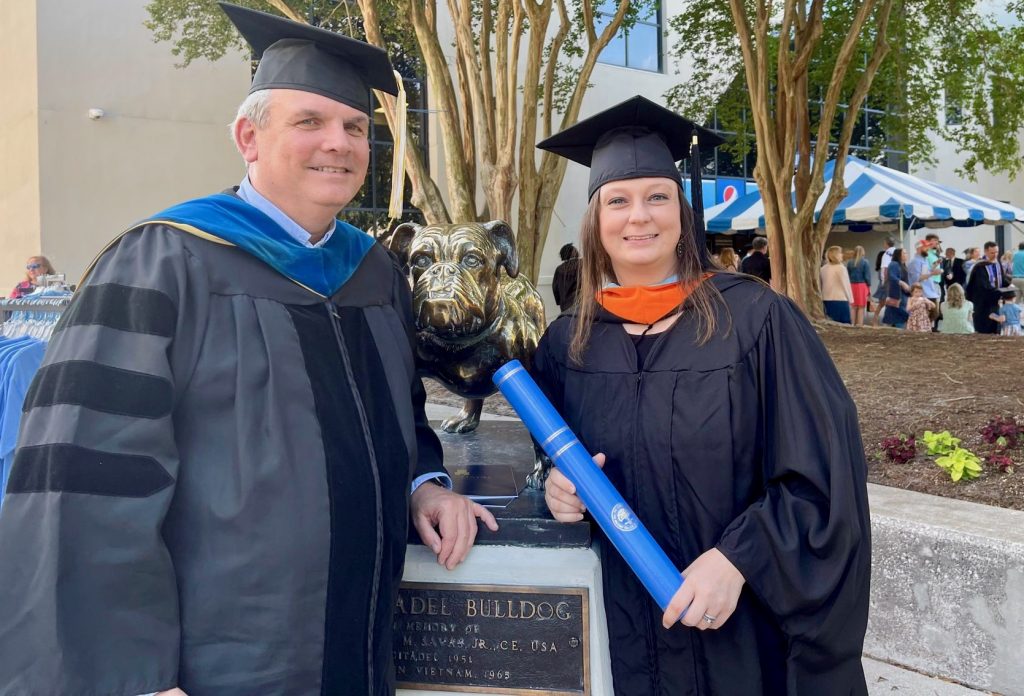
The leading causes of death in the United States include heart disease, obesity, cancer, stroke, and chronic respiratory diseases. Ensuring an environment that allows people to be engaged in physical activity to access grocery stores and daily community designations contributes to active mobility and increased overall public health outcomes.
“That’s why it is crucially important to consider essential built environment infrastructure supporting active transportation,” said Dimitra Michalaka, associate professor of civil engineering at The Citadel. “We created a novel graduate-level course to provide fundamental educational content at the convergence of public health, physical activity, transportation infrastructure, and the built environment.”
The course, established through a grant from the STRIDE Center, the 2016 U.S. Department of Transportation Regional (Southeast) University Transportation Center housed at the University of Florida Transportation Institute, home of the I-STREET Living Lab Initiative, focused on preparing graduate students and professionals to better address the consequential intersection of public health, land use and mobility.
Students across multiple disciplines including transportation engineering, city planning, public health, physical activity, land scape architecture, and public administration were the collective target audience for this course. Curriculum was created to support educational objectives focusing on relationships and effects of transportation infrastructure on public health outcomes as well as traffic congestion. The course also tasked students with identifying positive and adverse effects of the built environment on levels of physical activity. Students also assessed measures of public health, with an emphasis on policy creation and project level approaches for improving desirable outcomes supporting healthier communities.
MacKenzie Kelley, was a student in this course. She is a construction project manager at Charleston County Public Works in Charleston, South Carolina. Kelley says that in her job, she sees the overlap of local engineering and public health professionals who each bring their own perspectives on the built environment. Taking the class has made her more aware to the importance of including healthy community considerations into her work.
“We held deep discussions evaluating cities, suburban communities, and neighborhoods on their positive and adverse effects of the built environment, on levels of physical activity, and measures of public health,” she said. “When designing new transportation systems across the Low-country, I am now more aware and have the necessary proficiencies to develop more healthy communities that emphasize and encourage physical activity.”
While there are many public health and built environment courses available, curriculum is generally taught in academic programs related to public health, environmental sciences, and city planning. As of this course offering, no other similar courses were known to be offered within engineering degree programs.
“It was an obvious natural fit to include physical activity and public health as performance outcomes for transportation infrastructure and measure of urban mobility,” said Dr. Daniel Bornstein, physical activity researcher formerly at The Citadel and course co-professor. “Engaging students from parallel academic fields is highly beneficial to establishing shared proficiencies needed to synergistically identify and deliver effective infrastructure and societal solutions.”
The course was offered in the summer of 2019 as a 3-credit graduate class with collaboration from the Medical University of South Carolina, Clemson University, and College of Charleston. The STRIDE funded project that supported course creation is entitled Understanding Relationships Between Built Environment, Physical Activity, Public Health, Urban Mobility and Traffic Congestion: Graduate Curriculum.
As a result of establishing and offering this course, findings support that implementing optimal solutions needed to address complex urban mobility problems can be advanced by transcending traditionally siloed approaches in delivering academic programs. Furthermore, faculty conclude crosscutting multidisciplinary curriculum can be effective in preparing graduates with requisite perspectives, knowledge, and capabilities to develop collaborative approaches to improving physical activity, public health, equity, built environment, and traffic congestion outcomes.
Course materials, including the final report and project brief will be posted on the project’s website at https://stride.ce.ufl.edu/project-l2/.
For more information, contact:
Dr. Dimitra Michalaka, The Citadel at dmichala@citadel.edu
Dr. William J. Davis, The Citadel at davisj7@citadel.edu